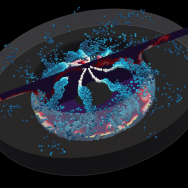For the past quarter-century, the Advanced Photon Source at Argonne National Laboratory has helped scientists and engineers make groundbreaking discoveries—providing extremely bright X-rays to investigate everything from dinosaur bones and lunar rocks to materials for new solar panels and new pharmaceutical drugs.
By accelerating particles to nearly the speed of light, the APS creates X-rays that researchers can use to peer through dense materials and illuminate the structure and chemistry of matter at the molecular and atomic level. Now Argonne, which is operated by the University of Chicago, been cleared to begin building a massive, $815 million upgrade to its kilometer-long X-ray facility.
The U.S. Department of Energy recently announced that the design report for the upgrade has been finalized and that the laboratory could begin moving forward with procurement and construction. Upon completion, the upgrade will equip scientists with a vastly more powerful tool for extending their research into new realms, accelerating impactful discoveries in science and technology.
“This project will be a scientific game-changer,” said Argonne scientist Robert Hettel, director of the APS Upgrade project. “The APS upgrade will allow researchers to see things at a scale they have never seen before with storage-ring X-rays. We’ll be able to look deep inside real samples, such as biological organisms, and observe atoms moving in real time. Such extreme levels of detail will open new frontiers and discoveries in basic science and help solve pressing problems across a wide range of industries.”
Among potential discoveries are revolutionary systems to convert sunlight into energy and ways to store that energy; new drugs to treat infections resistant to today’s antibiotics; a better understanding of the way the brain processes and stores information with neurons; detailed mechanisms by which pollutants move through soil; transformational understanding of the structure of the Earth’s inner core; and cleaner, more efficient biofuels.
“Virtually every department in the sciences and engineering here at the University of Chicago has multiple faculty members whose research relies on the Advanced Photon Source, from molecular engineers, to geoscientists to astronomers,” said Juan de Pablo, vice president for national laboratories and the Liew Family Professor in Molecular Engineering at UChicago. “It’s an extraordinary resource for the nation, and we are thrilled to see it go forward and to contribute towards its development.”
The upgrade will increase the brightness of the already super-bright X-rays another 100 to 1,000 times over the present facility, and depending on the technique used, will allow scientists to map the position, identity and dynamics of the key atoms in a sample.
Science at an even bigger scale
Every year, more than 5,500 researchers from every U.S. state and countries across the world conduct experiments at the APS. That research has led to two Nobel Prizes (and contributed to a third), supported the development of numerous pharmaceuticals (including one of the most successful drugs to stop the progression of the HIV virus), and improved products including more efficient vehicles and more powerful electronics.
Scientists at the APS have also uncovered secrets of history and archaeology by studying the composition of an ancient Egyptian mummy and the arms of SUE, the Tyrannosaurus rex specimen at The Field Museum of Chicago.
“This project will be a scientific game-changer. The APS upgrade will allow researchers to see things at a scale they have never seen before.”
In addition, APS research has increased our understanding of our solar system and the Earth itself through studies of meteorites, space dust and geological rocks and minerals.
“The upgraded APS will enable science at a completely new scale, enabling discoveries across a wide range of research—from microelectronics to polymers to quantum,” said Paul Kearns, director of Argonne National Laboratory.
The upgrade comes as Argonne also prepares to host what will be the most powerful supercomputer ever built in the U.S. Called “Aurora,” it will be capable of a quintillion—or one billion billion—calculations per second.
“It’s an exciting time as Argonne is building two powerful facilities for the world’s scientific community,” said Kearns. “Together, the upgraded APS and our Aurora exascale computing system will provide powerful new capabilities to accelerate science and technology for U.S. prosperity and security.”
Removal of the old storage ring and installation of the new one is planned to begin in June 2022. This installation and subsequent ring commissioning period will last for about one year, after which the APS-U X-ray beamlines will be brought online for researchers.
—Adapted from an article originally posted on the Argonne website.











